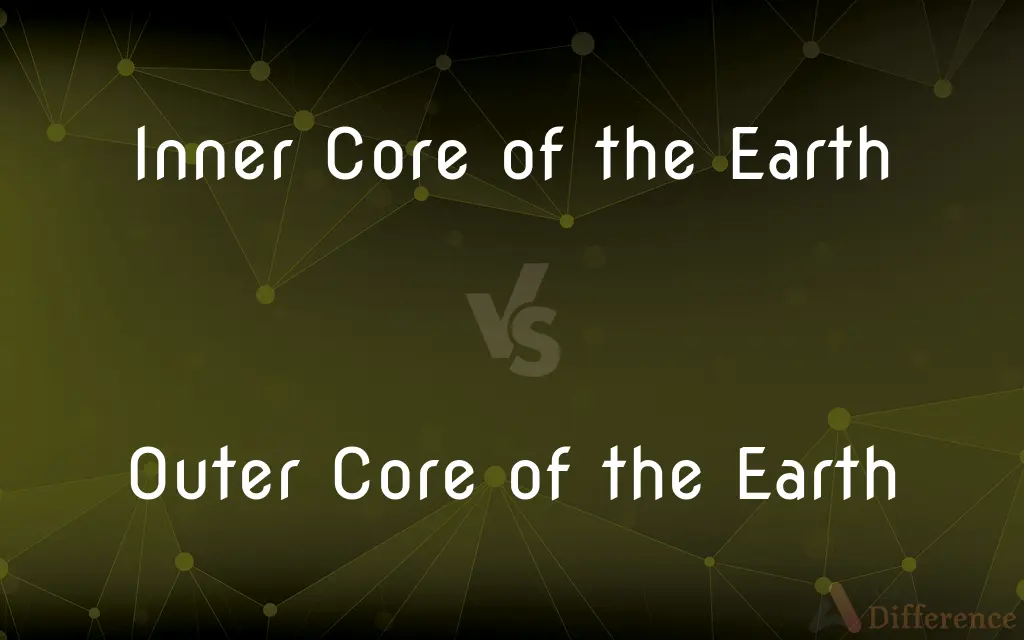Inner Core of the Earth vs. Outer Core of the Earth — What's the Difference?
By Tayyaba Rehman & Urooj Arif — Published on January 31, 2024
The Inner Core of the Earth is a solid sphere composed of iron and nickel, while the Outer Core is a fluid layer of the same elements, surrounding the Inner Core.

Difference Between Inner Core of the Earth and Outer Core of the Earth
Table of Contents
ADVERTISEMENT
Key Differences
The Inner Core of the Earth is a solid sphere composed primarily of iron and nickel, located at the planet's center. In contrast, the Outer Core of the Earth is a fluid layer surrounding the inner core, also primarily composed of iron and nickel but in a molten state.
While the Inner Core is solid due to immense pressure that prevents the iron and nickel from melting, the Outer Core, despite having similar compositions, remains liquid due to comparatively lower pressure and higher temperatures.
The Inner Core is characterized by its extreme density and temperatures, reaching up to 5,700 K. Conversely, the Outer Core, although still extremely hot, has lower temperatures and density compared to the inner core.
Seismic studies suggest that the Inner Core may be rotating at a different speed than the rest of the Earth. The Outer Core plays a crucial role in Earth's magnetic field generation through its dynamic, convective movements.
The Inner Core is smaller in radius, about 1,220 kilometers, while the Outer Core is significantly larger, extending up to 2,200 kilometers in thickness.
ADVERTISEMENT
Comparison Chart
State
Solid
Liquid
Composition
Mostly iron and nickel
Mostly molten iron and nickel
Temperature
Up to 5,700 K
Slightly lower than the inner core
Role in Earth's Magnetic Field
Limited direct role
Crucial for generating the magnetic field
Size
Smaller radius (about 1,220 km)
Larger, with a thickness of about 2,200 km
Compare with Definitions
Inner Core of the Earth
Subject to immense pressure.
The immense pressure at Earth's center keeps the inner core solid.
Outer Core of the Earth
A liquid layer surrounding the inner core.
The outer core's liquid state allows for the convection necessary for magnetic field generation.
Inner Core of the Earth
Exhibits differential rotation relative to Earth's surface.
Seismic data suggests the inner core rotates at a different speed than the surface.
Outer Core of the Earth
Plays a key role in Earth's magnetic field.
Movements in the outer core are essential for the dynamo effect that generates Earth's magnetic field.
Inner Core of the Earth
Earth's innermost, solid sphere.
The Earth's inner core remains solid despite extreme temperatures.
Outer Core of the Earth
Has a thickness of about 2,200 kilometers.
The outer core extends from below the mantle to the edge of the inner core.
Inner Core of the Earth
Has a radius of about 1,220 kilometers.
The inner core's radius is about one-fifth of Earth's total radius.
Outer Core of the Earth
Composed of molten iron and nickel.
The outer core's composition includes molten iron and nickel, similar to the inner core.
Inner Core of the Earth
Composed primarily of iron and nickel.
Studies of seismic waves reveal the iron-nickel composition of the inner core.
Outer Core of the Earth
Characterized by convective movements.
The convective movements in the outer core are driven by temperature and pressure differences.
Common Curiosities
What state is the Outer Core of the Earth in?
It is in a liquid state.
Is the Inner Core solid or liquid?
It is solid, despite the high temperatures.
What is the Inner Core of the Earth made of?
Primarily iron and nickel in a solid state.
Does the Inner Core rotate?
Yes, possibly at a different speed than the Earth's surface.
Does the Outer Core contribute to Earth's magnetic field?
Yes, its movements are crucial for magnetic field generation.
Why is the Outer Core liquid?
Due to lower pressure and high temperatures, preventing solidification.
What are the main elements in the Outer Core?
Molten iron and nickel.
What is the thickness of the Outer Core?
About 2,200 kilometers.
How hot is the Inner Core?
Temperatures can reach up to 5,700 Kelvin.
Is the Outer Core denser than the Inner Core?
No, the inner core is denser.
Can we directly observe the Inner Core?
No, it can only be studied indirectly through seismic data.
How does the Inner Core affect Earth's magnetic field?
It has a limited direct effect compared to the outer core.
How does the Outer Core affect Earth's geology?
It influences geomagnetic phenomena and contributes to plate tectonics.
How was the existence of the Inner Core discovered?
Through analysis of seismic wave patterns.
Are there any significant differences in composition between the Inner and Outer Core?
Their compositions are similar, but their states (solid vs. liquid) differ.
Share Your Discovery

Previous Comparison
Feta Cheese vs. Ricotta Cheese
Next Comparison
JPEG vs. TIFFAuthor Spotlight
Written by
Tayyaba RehmanTayyaba Rehman is a distinguished writer, currently serving as a primary contributor to askdifference.com. As a researcher in semantics and etymology, Tayyaba's passion for the complexity of languages and their distinctions has found a perfect home on the platform. Tayyaba delves into the intricacies of language, distinguishing between commonly confused words and phrases, thereby providing clarity for readers worldwide.
Co-written by
Urooj ArifUrooj is a skilled content writer at Ask Difference, known for her exceptional ability to simplify complex topics into engaging and informative content. With a passion for research and a flair for clear, concise writing, she consistently delivers articles that resonate with our diverse audience.













































